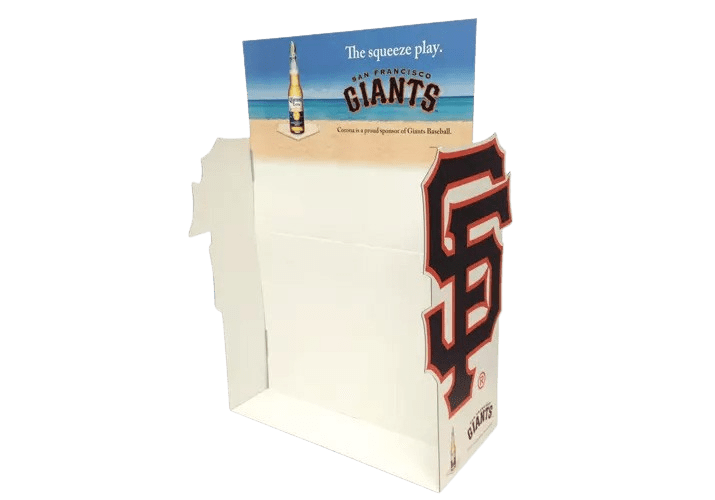The Sports Equipment market generated more than $171 billion globally in 2024 and is expected to grow at an annual rate of 5.86%. Investing in display strategies can help companies increase their influence and revenue.
It’s crucial for sports and outdoor companies to implement display strategies catered to their target audiences and placed in the right location to attract attention. Read on for some of the best display strategies for this vibrant industry.
Benefits of Display Strategies for Sports and Outdoor Businesses
Attractive displays can offer sports and outdoor businesses many benefits when used strategically. Here are some examples of the pros companies can expect:
- Increases brand awareness: Display strategies can help make your brand more recognizable, especially in high-traffic areas like retail environments.
- Improves the aesthetic: Placing products into attractive displays can make the retail area appear more organized and visually appealing. Unique designs can also stir excitement around an item.
- Enhances product condition: Sturdy displays can help your products stay in peak condition by protecting them from falling off shelves. They offer a clean and organized storage space that makes it easy for shoppers to take items off.
Top Display Strategies for Sports and Outdoor Companies
From using color theory to incorporating experiential marketing techniques, there are many ways to create more excitement and engagement with your displays. Here are the top strategies sports and outdoor companies should implement:
Use Color to Attract
Colors can evoke emotions and behaviors in customers. Sports retail merchandising is about creating marketing strategies that reflect the customer’s desires and aspirations associated with a product.
Studies show that shoppers reach conclusions about a product in 90 seconds and 62%-90% of this consideration is based purely on colors. Using the right shades can boost the number of impulsive purchases and attract your target audience. Outdoor and sporting activities are usually associated with yellow, orange, red and blue colors.
Colors can also reflect different levels of sporting products, such as black and red for advanced and blue and yellow for beginners. This method allows different shades to function as auxiliary tools that make the shopper’s experience with your brand run smoother.
Sort According to Brand
Displaying sports and outdoor goods according to brands has its pros and cons. For brands that provide premium products, this method could be very effective in helping shoppers find items from their favorite labels. However, it could backfire for those with a medium-price segment if a shopper doesn’t like a particular brand at the front of the aisle.
Determine which audience your brand targets and consult with the store accordingly to ensure your products get their attention.
Here are some of the benefits of displaying sporting and outdoor products according to brands that high-end companies can expect to enjoy:
- Enhances brand loyalty: Customers who prefer some brands over others may prefer this arrangement because they can find all the items from their preferred brands in one section.
- Provides cross-selling opportunities: By placing all items from one brand in one section, you can increase cross-selling and encourage shoppers to try a more comprehensive array of your products.
- Improves inventory management: Sorting products according to brand can make it easier to restock shelves and keep track of stock levels, which helps companies ensure their products are readily available.
Create Window Displays
Window displays and other outdoor merchandising strategies can draw customers into a store to try or purchase a particular product. When shoppers see enticing displays, they are more likely to remember the sporting brand later, even if they don’t buy on that day.
Window displays can also trigger the thought of a relevant event or season, pushing shoppers to make a purchase. For example, displays promoting snowboards, gloves and skiing equipment would entice passersby in winter.
Here are some tips for creating effective window displays:
- Use a clear and relatable theme for your target audience.
- Create a focal point that draws attention directly to your product or shows it as a complementary item.
- Tell a story about how the product is used for daily or special events.
- Create a balanced look that’s not too busy and allows customers to gauge what it’s about at first glance.
- Change the products in the window display to match the seasons or trends to reflect your customers’ priorities.
Enhance Store Navigation
Studies show that optimizing display allocation can lead to an 11.15% increase in store revenue. This technique increases shoppers’ ability to find your products. Advise store managers or merchandisers to allocate your product display in a relevant section. Here’s how sporting and outdoor displays are typically organized for optimal navigation:
- Gender and age: Place sporting and outdoor clothing items and shoes according to the appropriate gender and age group.
- Point-of-sale (POS) and endcaps: If your products are likely to be impulse buys, such as fashionable sporting accessories or nifty outdoor gadgets, place them near the checkout. Endcaps are a great place for featured items and special deals so these items can stand out.
- Complementary products: Combine products that are typically used together, like resistance bands and pilates rings. Shoppers tend to purchase items they can use together, which allows shops to easily cross-promote.
- Zones: Sporting and outdoor products can be categorized into different themed zones. For instance, all tennis apparel and equipment can be in a tennis-themed zone. Similarly, outdoor goods, such as camping items, should be in one zone for easy access.
Use Experiential Marketing
Experiential marketing is an effective strategy for increasing customer engagement and allowing shoppers to interact directly with your brand. You can use this strategy to execute practical outdoor gear display ideas.
Experiential marketing is also known as participation marketing, engagement marketing and live marketing because it places the shopper at the center of the strategy. Here are the top tips for effective experiential marketing:
- Create Instagrammable designs using selfie frames, funny backgrounds or trendy aesthetics.
- Find ways to use the display to engage the shopper’s five senses. Using descriptive text is a popular approach.
- Focus on wellness since most customers in the sporting and outdoor aisles are looking for ways to be healthier.
- Build emotional and memorable experiences with displays that play on the nostalgia or desires of a target audience.
Get Custom Temporary Displays From Creative Displays Now!
At Creative Displays Now, we specialize in building custom corrugated cardboard temporary displays that allow sporting goods companies to show off their products in a more sustainable and less expensive way than permanent options. Our displays enable businesses to stay on trend and our structural designers create strategic displays to maximize product visibility, boost engagement and increase sales in retail stores.
With over 60 years in the display and packaging business, we know exactly what works in major retail stores. Our experience allows us to create retail displays that fit the requirements of major retail stores with no hassle. Contact us and let us help you showcase your products in a way that draws attention and sales.



